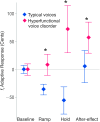Evidence for Auditory-Motor Impairment in Individuals With Hyperfunctional Voice Disorders
- PMID: 28590007
- PMCID: PMC5544411
- DOI: 10.1044/2017_JSLHR-S-16-0282
Evidence for Auditory-Motor Impairment in Individuals With Hyperfunctional Voice Disorders
Abstract
Purpose: The vocal auditory-motor control of individuals with hyperfunctional voice disorders was examined using a sensorimotor adaptation paradigm.
Method: Nine individuals with hyperfunctional voice disorders and 9 individuals with typical voices produced sustained vowels over 160 trials in 2 separate conditions: (a) while experiencing gradual upward perturbations in the fundamental frequency (fo) of their auditory feedback (shift-up) and (b) under no auditory perturbation (control). The shift-up condition consisted of 4 ordered (fixed) phases: baseline (no perturbation), ramp (gradual increases in heard fo), hold (a consistently higher heard fo), and after-effect (no perturbation). Adaptive responses were defined as the difference in produced fo during control and shift-up conditions.
Results: Adaptive responses were significantly different between groups. Individuals with typical voices generally showed compensatory adaptive responses, with decreased fo during the ramp and hold phases. Conversely, many individuals with hyperfunctional voice disorders instead displayed the opposite effect by following the direction of the perturbation. When fo was experimentally increased, speakers further increased their fo.
Conclusion: Results indicate that some individuals diagnosed with hyperfunctional voice disorders have disrupted auditory-motor control, suggesting atypical neurological function. These findings may eventually allow for the development of new interventions for hyperfunctional voice disorders.
Figures


Similar articles
-
Impaired auditory discrimination and auditory-motor integration in hyperfunctional voice disorders.Sci Rep. 2021 Jun 23;11(1):13123. doi: 10.1038/s41598-021-92250-8. Sci Rep. 2021. PMID: 34162907 Free PMC article.
-
Sensorimotor adaptation of voice fundamental frequency in Parkinson's disease.PLoS One. 2018 Jan 26;13(1):e0191839. doi: 10.1371/journal.pone.0191839. eCollection 2018. PLoS One. 2018. PMID: 29373589 Free PMC article.
-
Auditory-Motor Control of Fundamental Frequency in Vocal Vibrato.J Voice. 2023 Mar;37(2):296.e9-296.e19. doi: 10.1016/j.jvoice.2020.12.049. Epub 2021 Jan 16. J Voice. 2023. PMID: 33461882 Free PMC article.
-
Sensorimotor Integration in Patients with Voice Disorders: A Scoping Review of Behavioral Research.Folia Phoniatr Logop. 2024;76(6):501-520. doi: 10.1159/000538661. Epub 2024 Apr 3. Folia Phoniatr Logop. 2024. PMID: 38569477
-
Long-term outcome of hyperfunctional voice disorders based on a multiparameter approach.J Voice. 2007 Mar;21(2):179-88. doi: 10.1016/j.jvoice.2005.11.002. Epub 2006 Feb 28. J Voice. 2007. PMID: 16504466 Review.
Cited by
-
Pitch Discrimination Testing in Patients with a Voice Disorder.J Clin Med. 2022 Jan 24;11(3):584. doi: 10.3390/jcm11030584. J Clin Med. 2022. PMID: 35160036 Free PMC article.
-
Relationships between vocal pitch perception and production: a developmental perspective.Sci Rep. 2020 Mar 3;10(1):3912. doi: 10.1038/s41598-020-60756-2. Sci Rep. 2020. PMID: 32127585 Free PMC article.
-
Compensatory Responses to Formant Perturbations Proportionally Decrease as Perturbations Increase.J Speech Lang Hear Res. 2020 Oct 16;63(10):3392-3407. doi: 10.1044/2020_JSLHR-19-00422. Epub 2020 Sep 24. J Speech Lang Hear Res. 2020. PMID: 32976078 Free PMC article.
-
Impaired auditory discrimination and auditory-motor integration in hyperfunctional voice disorders.Sci Rep. 2021 Jun 23;11(1):13123. doi: 10.1038/s41598-021-92250-8. Sci Rep. 2021. PMID: 34162907 Free PMC article.
-
Quantitative Assessment of Learning and Retention in Virtual Vocal Function Exercises.J Speech Lang Hear Res. 2021 Jan 14;64(1):1-15. doi: 10.1044/2020_JSLHR-20-00357. Epub 2020 Dec 7. J Speech Lang Hear Res. 2021. PMID: 33285082 Free PMC article.
References
-
- Altman K. W., Atkinson C., & Lazarus C. (2005). Current and emerging concepts in muscle tension dysphonia: A 30-month review. Journal of Voice, 19, 261–267. - PubMed
-
- Arends N., Povel D. J., Van Os E., & Speth L. (1990). Predicting voice quality of deaf speakers on the basis of glottal characteristics. Journal of Speech and Hearing Research, 33, 116–122. - PubMed
-
- Arnold G. E. (1959). Spastic dysphonia: I. Changing interpretations of a persistent affliction. Logos, 2(3), 3–14.
-
- Aronson A. E. (1990). Clinical voice disorders: An interdisciplinary approach (3rd ed.). New York, NY: Thieme, Inc.
Publication types
MeSH terms
Grants and funding
LinkOut - more resources
Full Text Sources
Other Literature Sources
Medical

